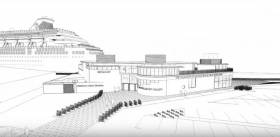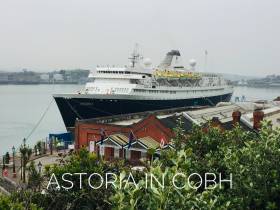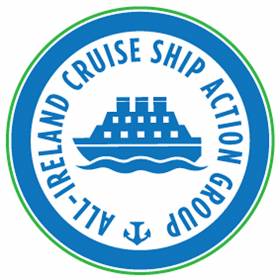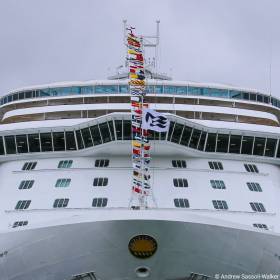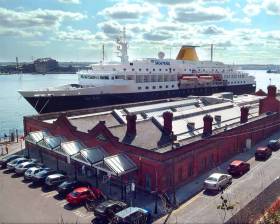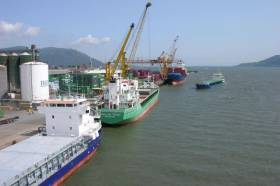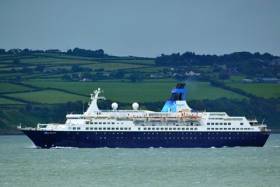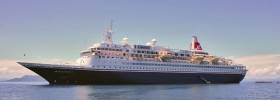Displaying items by tag: Cruise Liners
‘Iconic’ Cruise Visitor Plans Approved for The Clyde
Plans have been approved for an iconic building on the banks of the Clyde at Greenock in the North Channel of the Irish Sea to welcome cruise ship passengers.
The plans, approved this month by Inverclyde planning board, are for a new visitor centre, restaurant and gallery at Greenock Ocean Terminal.
The overall project, led by Inverclyde Council, is part of the Glasgow City Region City Deal and aims to provide a new berthing facility and visitor centre to boost cruise ship passengers welcomed to Scotland through the Greenock facility operated by Peel Ports.
Now a key milestone, planning permission, has been granted.
In addition to the state of the art visitor centre welcoming cruise ship passengers from across the world, the plans also include a purpose-built gallery celebrating the work of Inverclyde resident and artist George Wyllie (1921-2012) and a new restaurant with panoramic views across the Clyde.
As part of the outline business case published by Inverclyde Council, it is estimated that over 150,000 passengers could pass through Greenock Ocean Terminal delivering £26m in annual visitor and crew spend to the Scottish economy.
Inverclyde Council Leader Councillor Stephen McCabe said: “Planning application approval is an important milestone in the delivery of this project as part of the Glasgow City Region City Deal. The aim of the project is to boost the capacity at Greenock Ocean Terminal for cruise ships. The addition of a restaurant and Wyllie Gallery will help to provide a year-round attraction for visitors to Greenock and Inverclyde at this iconic building on the banks of Clyde.
“As a key City Deal project, the new visitor centre at Greenock Ocean Terminal aims to make a significant contribution to economic growth and international tourism across the wider city region area.”
Councillor David Wilson, Inverclyde planning board convener, welcomed the approval of the planning application. He said: “This is a welcome application and one the board where wholehearted in their approval. Inverclyde has a great deal to offer the visitor whether coming to Scotland by cruise ship from all over the world or visiting from other parts of the United Kingdom. The new visitor centre, gallery and restaurant will enhance the offer to domestic and overseas visitors. The economic value of the cruise ship sector to Scotland is a key part of this project and its value to the country, particularly with the potential to substantially grow in future years, should not be underestimated.”
The proposal for a new Wyllie Gallery showcasing the life and work of the artist will also stage important exhibitions and events celebrating contemporary artists from across Scotland and further afield.
When the planning application was submitted, artist George Wyllie’s elder daughter, Louise Wyllie, said: “Inverclyde Council’s vision in realising this complex project is to be applauded.
“It has always been an ambition of The George Wyllie Foundation to celebrate and mark my father’s life and work in Inverclyde; an area which he loved and which was the lifeblood of all his art works.
“This exciting development at Ocean Terminal in Greenock marks a sea-change in the Foundation’s on-going voyage to mark his legacy as a ground-breaking artist and to make more people aware of his life’s work.
“Although making and creating art – be it music, plays or sculpture – was always a big part of his life, my father worked as a Customs and Excise officer for many years in this very spot. I know he would be thrilled that a world-class art space, designed by award-winning architect, Richard Murphy, was going to be part of a bigger picture which aims to inject new life into this area of Greenock.
Louise, who is also a trustee of the George Wyllie Foundation, added: “Giving access to arts for all was always part of my father’s approach to creativity and we can’t wait to get started on a host of exciting arts-for-all projects.”
The Greenock Ocean Terminal project to create a visitor centre and berthing facility is expected to cost £14.7m as part of the £1bn Glasgow City Region City Deal which is funded equally by the Scottish and UK governments.
The proposal for a new visitor centre landmark building for Greenock is being developed by Richard Murphy Architects, one of Scotland’s most celebrated architect firms. The company has won an unprecedented 22 RIBA Awards.
The visitor centre is scheduled for completion in 2020.
Protestors at Cobh Cruise Ships Urged to Stop
#corkharbour - A picket by protestors held at Port of Cork sites in Cobh due to a dispute over public rights of way have been asked to stop, due to concerns that it is giving a bad impression to cruise liner tourists.
Locals reports EchoLive.ie are aggrieved that access to the Five Foot Way on Deepwater Quay has been restricted when cruise liners are docked.
However, the Port of Cork has said it needs to close the area for health and safety reasons when incoming cruise liners are tying up and taking off.
The 580 passengers arriving on the first cruise liner of the season on Monday, the Astoria, were met with protesters and more demonstrations are planned if an agreement is not reached.
The protestors have moved to clarify they are not picketing against the liners but some local councillors urged them to pursue the matter through other avenues.
More on the story can be read through this link.
A group of businesses across the tourism, retail and transport sectors have come together to campaign against the Dublin Port Company’s surprise ban on cruise ships entering Dublin Port from 2021. The group, which will be known as the All-Ireland Cruise Ship Action Group (AICSAG) was launched today at an event in Buswells Hotel in Dublin.
The group was formed following Dublin Port’s recent decision is in stark contrast to their activity in the past ten years of promoting Dublin Port as a cruise destination and highlighting the benefits cruise ships bring to the Irish economy and tourism business.
As Afloat reported yesterday, Dublin Town, the not for profit organisation charged with creating a welcoming and economically viable city environment in Dublin, has also urged Dublin Port to reconsider its decision to cut cruise ship calls.
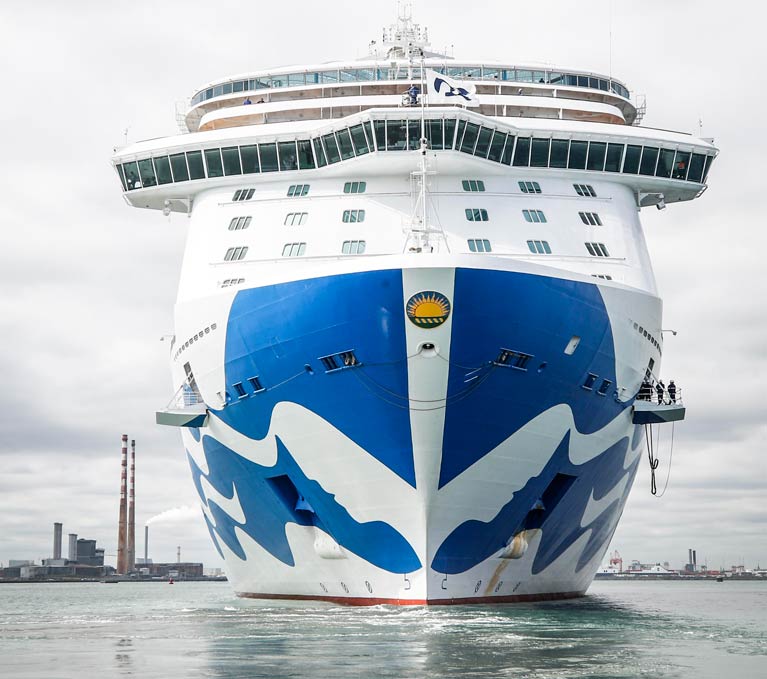 The 330m Royal Princess cruise ship that arrived in Dublin last year carrying more than 3,000 passengers and crew. Her arrival kickstarted a record cruise season for Dublin Port with 151 cruise calls confirmed for 2018, bringing just over 270,000 visitors to the city in 2018. Photo: Conor McCabe Photography.
The 330m Royal Princess cruise ship that arrived in Dublin last year carrying more than 3,000 passengers and crew. Her arrival kickstarted a record cruise season for Dublin Port with 151 cruise calls confirmed for 2018, bringing just over 270,000 visitors to the city in 2018. Photo: Conor McCabe Photography.
AICSAG will be ramping up its campaign to reverse the decision by hosting a series of roadshows and media briefings across the island of Ireland, stopping off at principal locations such as Belfast, Cork and Waterford before travelling to the west and northwest of Ireland. The group is made up of concerned businesses in the retail, transport and tourism sectors who will be severely impacted by Dublin Port’s move. The group has the backing of DublinTown and Retail Excellence Ireland.
According to the Group’s spokesperson Niamh McCarthy, Chief Executive of Excursions Ireland, the Dublin Port Company’s decision will ‘’devastate Irish tourism and is driving a death nail into our business. Last year, cruise ships brought over 442,000 visitors to Ireland and generated over €50 million for the Irish economy. If Dublin Port is allowed to go ahead with its plan, all of this will be lost forever. We are calling on Government and the Minister for Transport, Tourism and Sport to take immediate action to protect our jobs and businesses.’’
Niamh went on to say; ‘’for the past ten years, the Dublin Port Company have played an important role by increasing the numbers of cruise ships docking in Dublin and were at the forefront of highlighting their benefit to the Irish economy. Dublin Port have performed a complete sea change, to everyone’s amazement. Their latest damaging strategy has come out of nowhere and will risk the many thousands of jobs in Ireland dependent on the sector. This sudden change in policy is a total shock to both the all-Ireland tourism sector and its international stakeholders.’’
According to the other spokesperson, AICSAG member Feargal Barton of Barton’s Transport, the Dublin Port Company’s decision will also have a catastrophic impact on Ireland’s other port cities of Belfast, Cork and Waterford. ‘‘The cruise companies market Ireland as a destination, and in addition to Dublin the cruise ships stop off at Belfast, Waterford and Cork. Without access to Dublin Port, cruise companies will no longer stop in other Irish ports and will take their business to other European destinations. The cruise companies arrange cruises and marketing plans two years in advance, so urgent action is required to save the business for the 2021 season.’’
The recent decision by the Dublin Port Company to stop cruise ships docking at Dublin Port from 2021 was taken without any consultations or engagement with the Minister for Transport, Tourism and Sport, local businesses, Dublin City Council, or the other Irish ports, namely Belfast, Waterford and Cork, who will be severely impacted by this decision.
#CruiseLiners - Two million cruise passenger visitors made for a record breaking year at the Port of Southampton in 2017 according to AB Ports, the owner-operators of the UK's leading cruiseport.
The visitors brought with them a massive multi-million pound cash injection to the local economy.
Every time a cruise ship visits Southampton, it is estimated to bring a cash boost of £2m and in 2017 there more than 500 cruise calls.
ABP Southampton Director, Alastair Welch, said: “2017 was a record-breaking year for the Port of Southampton and 2018 looks set to be even busier.
“A huge amount of work goes into ensuring all passengers transit our facilities with the greatest of ease and it is testament to our whole port community that 2m cruise passengers receive Southampton’s world class service.”
In 2017 the port experienced its busiest long weekend ever when 15 cruise ships visited the port in June.
And it was recognised for the ninth consecutive year as the Best UK Departure Port by Cruise Critic UK editors.
In 2018 the port can look forward to:
· Eight maiden calls
· A naming ceremony for Azamara Pursuit following a major refit at Harland & Wolff, Belfast as reported on Afloat. The work in April is to be carried out by the Newry based speciliast fit-out firm, MJM Group.
Azamara Pursuit will be christened in Southampton in a first for Azamara Club Cruises. The lines other two ships, Azamara Journey and Azamara Quest, missed out on an official naming ceremony as they went straight into service after their original refurbishments.
Following the naming of Azamara Pursuit on 28 August, there will be a two-night celebratory cruise. Azamara Pursuit formerly sailed for P&O Cruises as Adonia (see Cuba cruises), and was acquired by Azamara in September 2017.
Azamara Chief Operating Officer Carol Cabezas said “This ship has a very strong British heritage and it has a fantastic following here. Plus we have seen a tremendous amount of demand from the UK audience. We’ve never had a christening in our brand’s history and we want to do that in Southampton.”
Also calling for the first time in Southampton will be: Aida Perla; Norwegian Bliss; MSC Meraviglia; Sapphire Princess; MS Zuiderdam; Seven Seas Navigator and MS Koningsdam.
On August 31 the port will experience a 6 ship day when Arcadia, Aurora, Braemar, Independence of the Seas, Mein Schiff 3 and Queen Victoria will all be alongside in Southampton. This day will showcase the diversity Southampton delivers for a range of lines and the breadth of off the cruise industry now has.
‘Saga Pearl 2’ Commences Port of Cork Cruise Season 2017
Saga Cruises’ MV Saga Pearl 2 will start the Port of Cork’s cruise liner season on 20th March, the first of 65 calls expected to visit Cork this season. Seven new liners will call this season on their maiden call, while Princess Cruises’ MV Caribbean Princess carrying 3,500 passengers will make fourteen visits this season.
With 65 calls in 2017, the Port of Cork anticipates a very busy season ahead for all involved, and an increased economic benefit for the region. Approximately 160,000 passengers and crew are expected to visit the city and county between March and November.
Commercial Manager at the Port of Cork, Captain Michael McCarthy said: ‘The 2017 Cork cruise season is booming which is great for the port and the region. The numbers of calls are up compared to 2016 and we feel very positive about this increase in business. It’s also very encouraging to see cruise lines bringing their newest vessels to Cork on maiden calls and choosing Cobh as part of their cruising route.’
He continued: ‘It is our ambition as a port company to attract larger cruise ships and increase our cruise calls to 75 per year. Already in 2018 the bookings are indicating we will achieve this goal, if not exceed it.’
In 2016 Cruise Critic, the world's leading cruise review site and online cruise community, announced the winners of the inaugural Cruise Critic Cruisers’ Choice Destination Awards with Cork’s Cobh ranked second favourite cruise destination in the British Isles and Western Europe. These awards recognised the high level of effort that goes into ensuring every cruise passenger visiting Cobh has a memorable visit to the region.
As well as Cork the Port of Cork also operates Bantry Bay Port Company which will see eight cruise liners calling to the West Cork area this summer. Bantry Harbour and Glengarriff can accommodate the smaller boutique cruise liners whose passengers tend to look for active expedition cruises.
Record Breaking Volumes for Warrenpoint Port
#Warrenpoint - Trade figures for Warrenpoint Harbour Authority released today reveal record volumes in tonnage of goods imported and exported through the Co. Down port for the year 2016.
The port recorded 3.48 million tonnes of cargo – a 7.4% growth on 2015 figures.
This reflects a record breaking achievement for the harbour authority whose new website highlights that a total of 969 vessels called to the port last year.
Volumes include significant increases in the roll-on/roll-off trade, containers, animal feed imports for the agri-food sector, timber and steel imports, export of cement and recyclables. In addition to various other general cargoes including coal and fertiliser.
New business included the development of the port as a cruiseship destination (Afloat adds the inaugural caller Saga Pearl II, firstly in 2014 and also last year). The port has also handed project cargoes including wind turbines.
Chief Executive, Mr Peter Conway, said “Another strong performance by the Port reflects the recent improvements in the economy both in Northern Ireland and the Republic of Ireland. The Port remains a major economic driver for its hinterland creating prosperity and securing additional employment”.
Former Dalkey Resident Is Godmother to Cruiseship Deployed On Direct Cruises from Dublin
#DirectCruises - Former resident of Bulloch, Dalkey, Co. Dublin, TV Broadcaster and radio personality, Gloria Hunniford who is godmother to CMV’s flagship Magellan is to make direct cruises from Dublin Port this season, writes Jehan Ashmore.
Hunniford who lived at Bartra Rock, a duplex apartment scheme close to Bulloch Harbour (see: proposed development), had named Cruise & Maritime Voyages (CMV) Magellan in 2015. The ceremony took place at the London Cruise Terminal in Tilbury. Originally launched as Carnival Cruises Holiday (1985/46,052grt). Among her names since the mid-80's have included Grand Holiday and she has proved a popular ship for her current UK owners. A couple of years ago Magellan made a maiden call to Dublin.
CMV specialise in providing no-fly cruising holidays aboard smaller to mid-sized ships with a traditional British cruise experience. The deployment of Magellan to Dublin is to cater for the Irish market this season by providing 'no-fly' cruises.
Ferdinand Magellan was a Portuguese explorer who organised the Spanish expedition to the East Indies that resulted in the first circumnavigation of the Earth. It is from the downriver terminal at Tilbury on the Thames that Magellen is to first make a Grand Maiden Round the World Cruise totalling 120 nights. This is to include Australia before she returns to Europe in May.
The next month Magellan will make direct cruises from Dublin Port following a departure from Newport, south Wales as previously reported on Afloat.
Afloat has identified a total of seven separate cruise calls of Magellan visiting Dublin this season. Of those en-route calls, 'five' cruises will permit passengers to directly embark in the capital's port from June. Examples been a ‘Iceland's Land of Ice & Fire’ cruise of 12 nights and to Spain, Portugal, France & Gibraltar of 11 nights duration.
Cruise-goers will be able to walk Magellan's outside timber decks in which nine are for her 1,250 passengers. Accommodation is in 726 cabins including 14 balcony suites.
Also in June a new fleetmate will follow with a call to the Irish capital, the Columbus which will be the successor flagship for CMV having acquired from P&O Cruises in Australia. The former Pacific Pearl's career in the southern hemisphere based out of Sydney. Since last year cruises have also been based from Auckland, New Zealand.
Columbus will easily be the largest of the five-strong fleet at 63,786 gross tonnage. Built for Sitmar Cruises in 1988 as Fair Majesty but never served as P&O took over the 1,400 passenger capacity vessel that has 775 cabins.
BBC Worldwide Launches Bespoke First Channel for Cruiseships
#TVCruiseChannel - BBC Worldwide has announced the launch of a global entertainment channel, BBC HD, the company’s first channel produced exclusively for cruiseships and the wider maritime market.
It will go live through Global Eagle Entertainment’s (GEE) MTN TV network, with P&O Cruises and Cunard being the first to offer this to their guests.
Content on the new channel will cover all genres ranging from drama, comedy and factual entertainment to natural history and documentaries. Fans of much loved soaps such as Eastenders, Holby City and Casualty will be delighted to know that these will air on BBC HD close to the UK broadcast so they can stay up to date with their favourite shows as they enjoy their cruise holiday.
BBC HD complements BBC World News, which launched on MTN TV in 2010 and is available on cruiseships throughout the world.
Zina Neophytou, Vice President, Out of Home, BBC Worldwide said: “There has always been a strong demand for BBC content within the travel and hospitality sectors including cruise ships so launching a bespoke global entertainment channel on MTN TV alongside BBC World News is an obvious step. BBC HD will be the one-stop shop for the best of British TV content.”
“The BBC was our initial launch partner when MTN TV was rolled out in 2010, and once again they are leading the way in pioneering more TV programming choices for cruising passengers around the world,” said Walé Adepoju, Executive Vice President, Media & Content at GEE. “The addition of the BBC HD channel is part of our expansion plan for MTN TV to provide more entertainment options relevant to today’s cruising market.”
P&O Cruises Senior Vice President Paul Ludlow, said: "We are delighted that our guests will be able to travel the world but still keep up with their favourite television shows for that touch of home. BBC HD will be a superb addition to our in cabin entertainment and I am sure will be welcomed by our guests on both P&O Cruises and Cunard."
As the launch customer BBC HD will be available on all P&O UK and Cunard ships with the channel also becoming available to the wider cruise industry in due course.
Dublin Port Cruise Calls To Increase in 2017 While Dun Laoghaire Remains With Last Year's Total
#CruiseIncrease – Dublin Port in 2017 is to welcome a total of 125 cruise calls an increase on last year, however Dun Laoghaire Harbour will have a repeat of last year with eight calls, writes Jehan Ashmore.
As previously reported on Afloat, Fred Olsen’s Boudicca became the first caller of the New Year and follows last year's total of 112 calls. Of these calls for season 2017 the most regular caller scheduled will be Princess Cruises 3,142 passenger 'Grand' class giant, Caribbean Princess.
The 112,894 gross tonnage ship hit the headlines for all the wrong reasons last year due to a power-failure and use of a 'magic polluting pipe'.
At Dun Laoghaire Harbour is where a handful of calls totalling eight cruiseships called in 2016. This is to be repeated with another welcome this year to the south Dublin Bay harbour. On previous seasons the total has been around a dozen calls.
The majority of callers been from operator Windstar Cruises. Once again their impressive five-mast sail assisted Wind Surf, the most frequent caller since the trade to the harbour was revived in 2011 is to make two visits in 2017. In addition to fleetmates but of conventional tonnage.
Afloat has examined the cruiseship list season 2017 and notably there will be no giant cruiseships making anchorage calls off Dun Laoghaire Harbour. This is due to smaller sized cruiseships and therefore they will be accommodated within the harbour alongside Carlisle Pier.
This year Dun Laoghaire Harbour can look forward to celebrating a significant milestone as it is the 200th anniversary of the beginning of its construction in 1817. This was to provide a port of 'refuge' with a single pier as originally planned. This pier ultimately became the East Pier, following the completion of this feat of marine engineering in 1842 with the building of the West Pier to form the ‘asylum’ harbour.
#CruiseFirst - A pair of Fred Olsen Lines sisters marked both the last cruise call to Dublin Port in 2016 and as the first of the New Year, writes Jehan Ashmore.
The conservative yet handsome profile of Boudicca sailed into Dublin at dawn. The 880 passenger cruiseship had sailed from the opposite side of the Irish Sea having cast off mooring ropes from Liverpool’s famous waterfront. The ship had berthed at the cruise terminal located near the landmark buildings known as the ‘Three Graces’.
On boards are cruise-goers taking in the early New Year sights and visiting tourist attractions of Dublin's 'Fair City' before Boudicca sets sail this evening at 18.00hrs. The next port of call been Southampton. Likewise of the Irish capital, the Hampshire port is the UK’s busiest for cruiseships along with trading in general cargo, notably through giant ocean-going containerships.
Within the last fortnight sister, Black Watch had too disembarked tourists to visit Dublin which in 2016 the port welcomed 112 cruiseships.
The veteran vessels of 28,000 gross tonnage each and dating to the 1970’s belong to an increasing rare breed of first generation cruiseships. With the passing of more than four decades they have become by default yet even more pleasing to the aesthestic eye.
In comparison to some of the behemoths of modern day cruiseships and newbuilds that will descend into the Dublin Port of the future using a new cruise €30m terminal granted planning permission.
The facility a first for the port is part of the Alexandra Basin Redevelopment (ABR) Project. This is phase one of the Masterplan for the port up to 2040.
Currently the vast majority of cruiseships dock in Alexandra Basin (west and east). It is in the east basin, the larger of the two where Boudicca of 206m in length is berthed alongside Ocean Pier. This is also where larger cruiseships of 300m in length dock while considerably smaller ships can head downriver close to the city quays.
Port access issues such as restrictions on overall cruiseship dimensions will be resolved by an extensive dredging programme within the port but also the approach channels off Poolbeg Lighthouse.
This will enable the largest cruiseships in the world to dock following realignment of quays within Alexandra Basin. Such works will permit these massive cruiseships up to 340m in length to swing around the increased turning circle inside the basin.




























